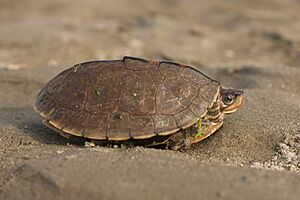Brown roofed turtle facts for kids
Quick facts for kids Brown roofed turtle |
|
|---|---|
 |
|
| Conservation status | |
| Scientific classification | |
| Genus: |
Pangshura
|
| Species: |
smithii
|
| Synonyms | |
|
|
The brown roofed turtle (Pangshura smithii) is a type of turtle that lives in South Asia. It is part of the Geoemydidae family of turtles. This species is special because it is endemic to South Asia, meaning it is found nowhere else in the world naturally. There are two different kinds, or subspecies, of the brown roofed turtle.
Contents
What's in a Name?
The scientific name for this turtle, smithii, was chosen to honor a Scottish zoologist named Andrew Smith. Zoologists are scientists who study animals.
Meet the Brown Roofed Turtle
The brown roofed turtle has a shell called a carapace. This shell is usually a pale olive-brown color on top. It looks a bit flat and has a slight ridge, or "keel," down its back. The ridge is often blackish.
The bottom part of the turtle's shell is called the plastron. It is dark brown with yellow edges. The front part of the plastron is rounded, and the back part has a small notch.
The turtle's head is a medium size. Its snout is short and rounded. The edges of its jaws are slightly toothed, like tiny saw blades. The upper jaw does not have a notch in the middle.
The front legs of the brown roofed turtle have large scales that go across them. These turtles can grow to about 8.5 inches (21.6 cm) long in a straight line across their shell.
Did you know that unlike most turtles, which have their sex determined by the temperature of their eggs, brown roofed turtles have their sex determined by their genes? This is called the ZZ/ZW sex-determination system.
Where Do They Live?
There are two main types, or subspecies, of the brown roofed turtle. Each lives in slightly different areas:
The P. s. smithii Subspecies
This subspecies is found in the big river systems of Bangladesh, India, and Pakistan. These rivers include the Indus, Ganges, and Brahmaputra Rivers. This type was first described by John Edward Gray in 1863.
The P. s. pallidipes Subspecies
This subspecies lives in the northern parts of the Ganges River system. You can find them in India and Nepal. This type was first described by Edward O. Moll in 1987.
Home Sweet Home
Brown roofed turtles love to live in freshwater swamps and rivers. They often prefer areas with muddy bottoms. These turtles also enjoy basking in the sun, which means lying in a warm spot to soak up the sun's rays. They usually do this twice a day!


